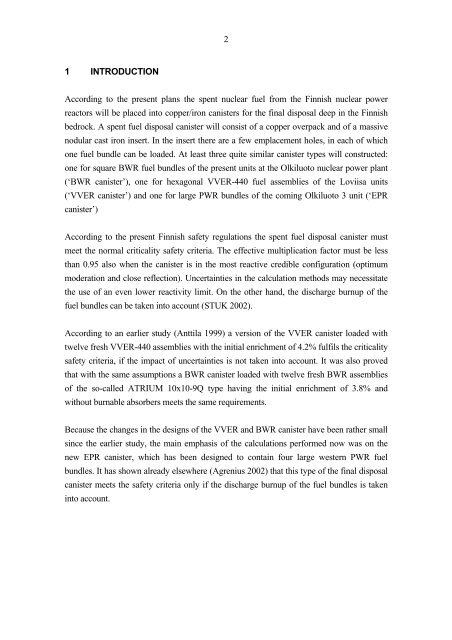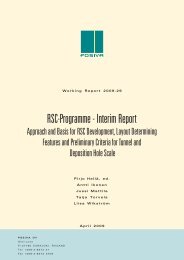Criticality Safety Calculations for Three Types of Final ... - Posiva
Criticality Safety Calculations for Three Types of Final ... - Posiva
Criticality Safety Calculations for Three Types of Final ... - Posiva
- No tags were found...
Create successful ePaper yourself
Turn your PDF publications into a flip-book with our unique Google optimized e-Paper software.
21 INTRODUCTIONAccording to the present plans the spent nuclear fuel from the Finnish nuclear powerreactors will be placed into copper/iron canisters <strong>for</strong> the final disposal deep in the Finnishbedrock. A spent fuel disposal canister will consist <strong>of</strong> a copper overpack and <strong>of</strong> a massivenodular cast iron insert. In the insert there are a few emplacement holes, in each <strong>of</strong> whichone fuel bundle can be loaded. At least three quite similar canister types will constructed:one <strong>for</strong> square BWR fuel bundles <strong>of</strong> the present units at the Olkiluoto nuclear power plant(‘BWR canister’), one <strong>for</strong> hexagonal VVER-440 fuel assemblies <strong>of</strong> the Loviisa units(‘VVER canister’) and one <strong>for</strong> large PWR bundles <strong>of</strong> the coming Olkiluoto 3 unit (‘EPRcanister’)According to the present Finnish safety regulations the spent fuel disposal canister mustmeet the normal criticality safety criteria. The effective multiplication factor must be lessthan 0.95 also when the canister is in the most reactive credible configuration (optimummoderation and close reflection). Uncertainties in the calculation methods may necessitatethe use <strong>of</strong> an even lower reactivity limit. On the other hand, the discharge burnup <strong>of</strong> thefuel bundles can be taken into account (STUK 2002).According to an earlier study (Anttila 1999) a version <strong>of</strong> the VVER canister loaded withtwelve fresh VVER-440 assemblies with the initial enrichment <strong>of</strong> 4.2% fulfils the criticalitysafety criteria, if the impact <strong>of</strong> uncertainties is not taken into account. It was also provedthat with the same assumptions a BWR canister loaded with twelve fresh BWR assemblies<strong>of</strong> the so-called ATRIUM 10x10-9Q type having the initial enrichment <strong>of</strong> 3.8% andwithout burnable absorbers meets the same requirements.Because the changes in the designs <strong>of</strong> the VVER and BWR canister have been rather smallsince the earlier study, the main emphasis <strong>of</strong> the calculations per<strong>for</strong>med now was on thenew EPR canister, which has been designed to contain four large western PWR fuelbundles. It has shown already elsewhere (Agrenius 2002) that this type <strong>of</strong> the final disposalcanister meets the safety criteria only if the discharge burnup <strong>of</strong> the fuel bundles is takeninto account.
















